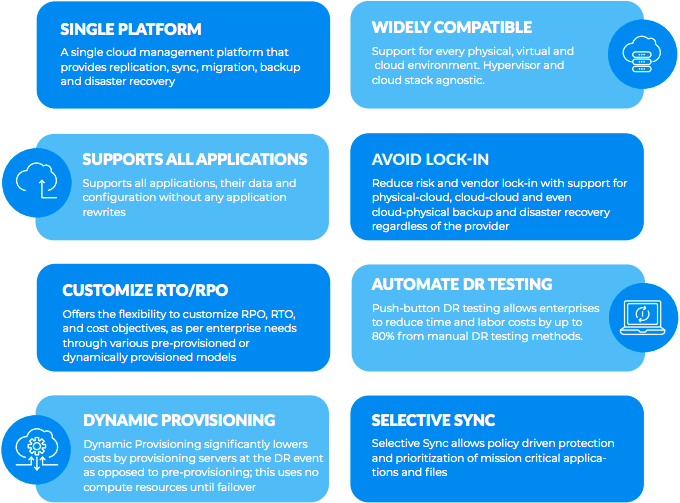Do you need a Disaster Recovery solution for your enterprise workloads? RackWare has a powerful, secure, fully automated solution that allows you to replicate and synchronize all of your active Servers (Windows and Linux) and Containers (Kubernetes and OpenShift) to any Cloud (Azure, AWS, IBM Cloud, Oracle Cloud, GCP). In the event of any type of extended outage RackWare’s solution allows you to failover your workloads into that geographically remote Cloud location and be back up and running in minutes.
Now you can try RackWare’s Disaster Recovery solution for free. Simply click on “Contact RackWare” and a RackWare representative will help you install our software and provide free licenses to get you started in the Cloud of your choice.
What is DRaaS and why is it useful?
What is DRaaS?
DRaaS, also known as disaster recovery as a service, is the replication of hosting of physical or virtual servers by a third party to provide failover in the event of a man made or natural catastrophe. DRaaS can be especially useful to organizations that lack the necessary expertise to provision, configure, and test an effective disaster recovery plan (DRP).
Why is DRaaS useful?
Millions of businesses around the world encounter some form of natural disaster. Imagine if a power outage, hardware failure, file corruption, human error, earthquake, flood, hurricane, thunderstorm, wildfire, winter weather, or tornado, strikes your data center. Major interruptions like your website going down or losing all your customer data will likely occur.
In Ponemon Institute’s “Cost of Data Center Outages” study, it was reported that unplanned downtime costs organizations an average cost of $8,850 per minute.
The Federal Emergency Management Agency (FEMA) reported that 43% of organizations affected by a natural disaster never reopen, and 29% of organizations affected close within two years of the occurrence.
DRaaS focuses on a short recovery point objective. This means that the data restored will be as close to its current “now” state as possible. Typical recovery time objectives are within 4 hours and will bring up machines geographically located in a different location. For example, if your datacenter in Florida gets affected by a hurricane, DRaaS ensures your data will not be lost by switching to live mirrored servers in Nevada, which was not affected by the hurricane.
What should you consider when choosing a DRaaS?
Get a performance service level agreement (SLA) - Create a contract between you and your service provider to ensure pre-defined performance (i.e. 1 hour SLA guaranteeing your critical applications will be up and running within an hour).
DRaaS costs are highly variable - Watch out for hidden fees (i.e. retrieval fees that charge per gigabyte which can substantially add up).
Couple DRaaS with data protection - The cloud is an ideal place for long-term data retention because it’s isolated from production data and remote from ransomware.
Pay for only what you use - Choose a provider that offers different DRaaS services for different classes of applications.
Cloud seeding options - With cloud seeding, you can use physical media (i.e. tape, server, hard disks, etc.) to pre-load your data to the cloud and restore a failed local database.
DRaaS can protect cloud applications - Deploy a backup appliance within the cloud and point your cloud applications to backup software in a different cloud facility than where your cloud applications are running.
Include automated test recovery - You should have automated testing at least once a month and after any changes to the infrastructure to ensure your applications will really recovery.
Advantages of purpose-built clouds - Purpose-built clouds have seamless integration between your backup appliances and the cloud, holistic support, and predictable recovery times.
Share this Image On Your Site
How can Rackware help?
Rackware develops cloud management software that allows enterprises to migrate applications, provide disaster recovery and backup, and hybrid cloud management.
The RackWare Management Module(RMM) provides enterprises IT resilience by automating disaster recovery and backup to any cloud. Some of our features include:
Why Rackware?
Improved Resiliency with Better RPO/RTO
Significantly improved support over traditional tape backup at a fraction of the cost required to maintain a replicated data center.
Multiple recovery point objective (RPO) and recovery time objective (RTO) options that gives you control over availability and costs. You can ensure that critical applications recover quickly while secondary applications do so in the most cost-effective time frame.
Pre-provisioned resources are launched in minutes to ensure a rapid RTO while auto recovery fallback ensures applications return to the primary data center for maximum performance.
Flexibility Between Data Center and Cloud, Physical & Virtual Environments
Delivers a truly heterogeneous approach, reducing multiple tools and helping users avoid lock-in of server vendor, hypervisor or cloud provider.
Enables users to dynamically scale physical, virtual and cloud resources across private and public environments as computing needs fluctuate, allowing enterprises to get the highest performance and availability out of their cloud.
Intelligently leverages cloud solutions for today’s applications.
For more information regarding how DRaaS can help you, contact us.


